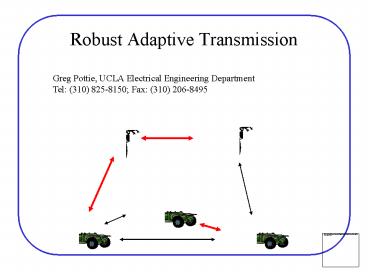Robust Adaptive Transmission PowerPoint PPT Presentation
1 / 13
Title: Robust Adaptive Transmission
1
Robust Adaptive Transmission
Greg Pottie, UCLA Electrical Engineering
Department Tel (310) 825-8150 Fax (310)
206-8495
2
Research Focus
- Dealing with high channel dynamics Doppler,
fading modify techniques proposed in other
contexts for Orthogonal Frequency Division
Multiplexing (OFDM) - Objective robust communication links, at maximum
possible rate for wide range of scenarios, using
systolic radios - Issues
- Jamming training sequence usually the weak link
apply spread spectrum methods to training signal - Complexity must implement in radios not merely
a study of optimal forms.
3
Robust and Adaptive Transmission
- Prior work on adaptive OFDM has considered both
time and frequency domain estimation - Has not considered rates of channel change
present in air/ground communications, nor jamming - Peak to average power ratio (PAR) reduction
techniques considered in isolation from other
training - Will consider multiple uses of coded training
sequences - Prior work on Multi-Input Multi-Output (MIMO)
largely concerned with slowly changing links - Will investigate how to have same adaptive
framework for single or many antennas, and fast
changing channel
4
Student Researcher Progress
- Equalization (S. Kim)
- Channel characterization, study of time and
frequency domain adaptive equalization techniques - Spread spectrum acquisition and synchronism
issues (R. Thrasher) - Survey of fast synchronism techniques
- Control and sensor traffic modeling (A. Pandya)
- Gathering data from formation flight experiments
- Peak power reduction techniques (H. Chen)
- Reduced complexity method
5
Channel Conditions
Air to Air Fast fading (almost frequency
non-selective, very time selective)
6
Channel Conditions
Ground to Ground Slow fading (highly frequency
selective, not very time selective)
7
Channel Conditions
Air to Ground Worst case (frequency and time
selective)
8
Channel Estimation
- Estimation in Time vs. Frequency
- Choice depends on the channel conditions
- Fast fading with short delay spread (air to air,
air to ground) - Time domain estimation
- Slow fading with long delay spread (ground to
ground) - Frequency domain estimation
- Can share training sequence among many
transceiver functions
9
Channel Estimation
- Snap-shot estimation and interpolation
Training symbols for channel estimation
Estimated channel
Interpolated channel
10
Conventional RLS equalization
11
BER performance ( Air to Ground )
12
Two Algorithmic Levels
- Channel identification fading rate, link loss,
interference levels, packet durationdetermines
OFDM/spread spectrum mix and basic tracking
approach - Channel tracking
- Synchronization frequency and time domain
methods - Equalization frequency and time domain methods
- PAR reduction in-band techniques making use of
coded training sequence - MIMO coding and adaptive array techniques
13
Deliverables
- Channel, traffic, and physical link models for
simulator and MAC development - Several generations of algorithms for
equalization, synchronization, PAR reduction, and
use of multiple antennas, taking into account
systolic radio architecture and MAC - Adaptive algorithms running on the systolic radio

